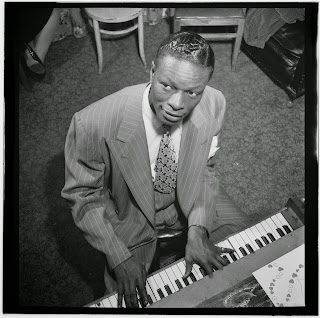The Unforgettable Nat King Cole
The Unforgettable Nat King Cole
By Shannon Stockwell
 |
| Nat King Cole in New York City. Photo by William P. Gottlieb, June 1947 |
Cole began performing in the mid 1930s when he was still a teenager, playing piano with his brother Eddie in jazz clubs. It was during this time that he acquired the nickname “Nat King Cole,” derived from the nursery rhyme about Old King Cole. After that, he became the pianist in the national tour of Broadway theater legend Eubie Blake’s revue Shuffle Along. The show went under in Long Beach, California, where Cole elected to stay.
Cole’s next big project was the King Cole Trio, made up of guitarist Oscar Moore, double bassist Wesley Prince, and Cole on the piano. In 1943 Cole penned the song that catapulted the trio to fame: “Straighten Up and Fly Right.” The song was recorded that winter after the trio signed with the fledgling Capitol Records, and it became a hit. As he played with the trio, audiences began to recognize Cole for his soft, clear baritone voice.
In the late 1940s and early ’50s, the King Cole Trio began to record and perform more pop-oriented melodies. Cole recorded his most popular songs during these years, including “The Christmas Song” (also known as “Chestnuts Roasting on an Open Fire”), which was recorded four times between 1946 and 1961.
In the late 1950s and early ’60s, Cole, along with his contemporaries, noticed that the pop ballads with which he had risen to fame did not seem to be selling well among younger generations. Still, he retained relevance. In 1961, “Let There Be Love,” similar in style to his pop ballads of the ’50s, was a number-one hit in Britain.
After a brief battle with lung cancer, Cole died on February 15, 1965, but his music and his clear, soft, articulate baritone live on. In the words of jazz musician and producer Dick Katz, his “deep groove, harmonic awareness, supple phrasing, touch, dynamics, taste, and just plain delicious music” have influenced generations of musicians and remain admired by critics, historians, and enthusiasts alike. “The musicality is just there,” says jazz musician Roger Kellaway. “It’s understood. It’s an assumption. His playing sparkles. And it seems effortless.” Aside from his mastery, Cole is beloved by fans for something more—a certain kindness and intimacy in his singing. “At his best and most characteristic, Nat Cole was not so much a singer as a whisperer, or, as one might put it, a confider,” said music critic Henry Pleasants. Kellaway sums it up well: “When you hear something like this, you think to yourself, ‘Boy, would I like to hang out with that person!’”
It was this intimate element of Nat King Cole’s music that attracted playwright Kwame Kwei-Armah when he was writing Let There Be Love. “[Alfred] lives in this world all by himself, in this big house with no family, with no friends anymore—just an absolutely lonely existence,” Kwei-Armah has said. “So I thought, ‘I need to give him something, some sort of musical friend, someone that he plays and has conversations with.’ And someone who made a huge impact on black music here was Nat King Cole. He represented a time in music when it was both sophisticated and beautiful, when it was both erudite and popular. Alfred could listen to him and think, ‘That’s my friend Nat.’”
For more about Let There be Love, be sure to read our latest edition of Words on Plays! Click here to order online.
For tickets to Let There be Love visit act-sf.org/love.

